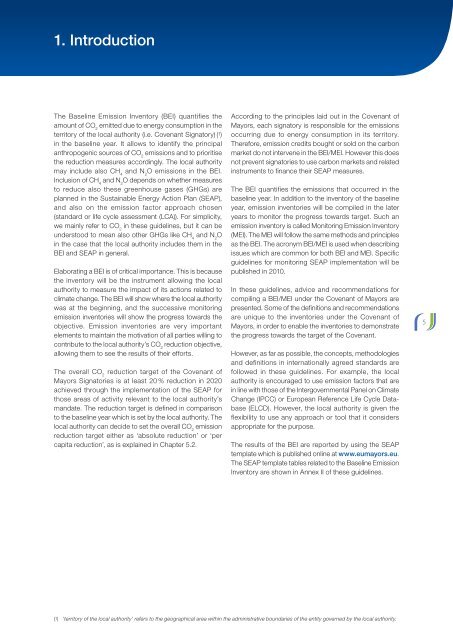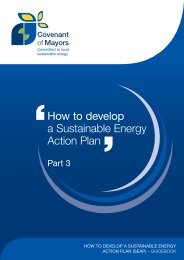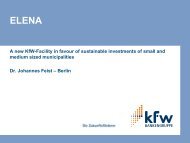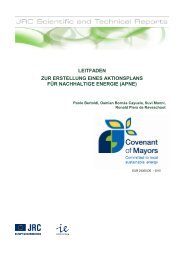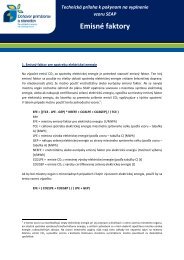English - Covenant of Mayors
English - Covenant of Mayors
English - Covenant of Mayors
You also want an ePaper? Increase the reach of your titles
YUMPU automatically turns print PDFs into web optimized ePapers that Google loves.
1. Introduction<br />
The Baseline Emission Inventory (BEI) quantifies the<br />
amount <strong>of</strong> CO 2<br />
emitted due to energy consumption in the<br />
territory <strong>of</strong> the local authority (i.e. <strong>Covenant</strong> Signatory) ( 1 )<br />
in the baseline year. It allows to identify the principal<br />
anthropogenic sources <strong>of</strong> CO 2<br />
emissions and to prioritise<br />
the reduction measures accordingly. The local authority<br />
may include also CH 4<br />
and N 2<br />
O emissions in the BEI.<br />
Inclusion <strong>of</strong> CH 4<br />
and N 2<br />
O depends on whether measures<br />
to reduce also these greenhouse gases (GHGs) are<br />
planned in the Sustainable Energy Action Plan (SEAP),<br />
and also on the emission factor approach chosen<br />
(standard or life cycle assessment (LCA)). For simplicity,<br />
we mainly refer to CO 2<br />
in these guidelines, but it can be<br />
understood to mean also other GHGs like CH 4<br />
and N 2<br />
O<br />
in the case that the local authority includes them in the<br />
BEI and SEAP in general.<br />
Elaborating a BEI is <strong>of</strong> critical importance. This is because<br />
the inventory will be the instrument allowing the local<br />
authority to measure the impact <strong>of</strong> its actions related to<br />
climate change. The BEI will show where the local authority<br />
was at the beginning, and the successive monitoring<br />
emission inventories will show the progress towards the<br />
objective. Emission inventories are very important<br />
elements to maintain the motivation <strong>of</strong> all parties willing to<br />
contribute to the local authority’s CO 2<br />
reduction objective,<br />
allowing them to see the results <strong>of</strong> their efforts.<br />
The overall CO 2<br />
reduction target <strong>of</strong> the <strong>Covenant</strong> <strong>of</strong><br />
<strong>Mayors</strong> Signatories is at least 20 % reduction in 2020<br />
achieved through the implementation <strong>of</strong> the SEAP for<br />
those areas <strong>of</strong> activity relevant to the local authority’s<br />
mandate. The reduction target is defined in comparison<br />
to the baseline year which is set by the local authority. The<br />
local authority can decide to set the overall CO 2<br />
emission<br />
reduction target either as ‘absolute reduction’ or ‘per<br />
capita reduction’, as is explained in Chapter 5.2.<br />
According to the principles laid out in the <strong>Covenant</strong> <strong>of</strong><br />
<strong>Mayors</strong>, each signatory is responsible for the emissions<br />
occurring due to energy consumption in its territory.<br />
Therefore, emission credits bought or sold on the carbon<br />
market do not intervene in the BEI/MEI. However this does<br />
not prevent signatories to use carbon markets and related<br />
instruments to finance their SEAP measures.<br />
The BEI quantifies the emissions that occurred in the<br />
baseline year. In addition to the inventory <strong>of</strong> the baseline<br />
year, emission inventories will be compiled in the later<br />
years to monitor the progress towards target. Such an<br />
emission inventory is called Monitoring Emission Inventory<br />
(MEI). The MEI will follow the same methods and principles<br />
as the BEI. The acronym BEI/MEI is used when describing<br />
issues which are common for both BEI and MEI. Specific<br />
guidelines for monitoring SEAP implementation will be<br />
published in 2010.<br />
In these guidelines, advice and recommendations for<br />
compiling a BEI/MEI under the <strong>Covenant</strong> <strong>of</strong> <strong>Mayors</strong> are<br />
presented. Some <strong>of</strong> the definitions and recommendations<br />
are unique to the inventories under the <strong>Covenant</strong> <strong>of</strong><br />
<strong>Mayors</strong>, in order to enable the inventories to demonstrate<br />
the progress towards the target <strong>of</strong> the <strong>Covenant</strong>.<br />
However, as far as possible, the concepts, methodologies<br />
and definitions in internationally agreed standards are<br />
followed in these guidelines. For example, the local<br />
authority is encouraged to use emission factors that are<br />
in line with those <strong>of</strong> the Intergovernmental Panel on Climate<br />
Change (IPCC) or European Reference Life Cycle Database<br />
(ELCD). However, the local authority is given the<br />
flexibility to use any approach or tool that it considers<br />
appropriate for the purpose.<br />
The results <strong>of</strong> the BEI are reported by using the SEAP<br />
template which is published online at www.eumayors.eu.<br />
The SEAP template tables related to the Baseline Emission<br />
Inventory are shown in Annex II <strong>of</strong> these guidelines.<br />
5<br />
(1) ‘territory <strong>of</strong> the local authority’ refers to the geographical area within the administrative boundaries <strong>of</strong> the entity governed by the local authority.


